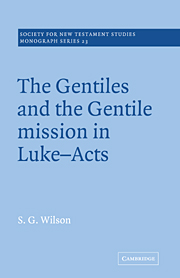Book contents
- Frontmatter
- Contents
- Abbreviations
- Preface
- 1 Jesus and the Gentiles
- 2 The Gentiles in Luke's Gospel
- 3 Lukan eschatology
- 4 The early chapters of Acts
- 5 Stephen and the Hellenists
- 6 Paul's conversion
- 7 Cornelius and the Apostolic Council
- 8 Paul's speech on the Areopagus
- 9 Jewish and Gentile missions
- 10 Summary and conclusions
- Bibliography
- Index of passages
- Index of authors
- Index of subjects
2 - The Gentiles in Luke's Gospel
Published online by Cambridge University Press: 04 March 2010
- Frontmatter
- Contents
- Abbreviations
- Preface
- 1 Jesus and the Gentiles
- 2 The Gentiles in Luke's Gospel
- 3 Lukan eschatology
- 4 The early chapters of Acts
- 5 Stephen and the Hellenists
- 6 Paul's conversion
- 7 Cornelius and the Apostolic Council
- 8 Paul's speech on the Areopagus
- 9 Jewish and Gentile missions
- 10 Summary and conclusions
- Bibliography
- Index of passages
- Index of authors
- Index of subjects
Summary
THE MARKAN VIEW
The previous chapter has, by implication, dealt with the Markan view of the Gentiles and the Gentile mission. However, before embarking on a study of the Gentiles in Luke's Gospel it is necessary to draw this material together and to summarise Mark's view. This will serve to clarify what has happened to the tradition from Jesus up to and including Mark, with which Luke's presentation can be compared to see if and how it differs.
Four passages are especially worthy of note. We shall state only our conclusions, since the arguments have already been given.
1. In Mk. 12: 1–9 we noted that Mark has probably added the reference to the ‘others’ in v. 9, although this is not certain. If he did add it then he has made a clear reference to the Gentiles which would otherwise be lacking in the parable. We noted also that it is almost certain that Mark has added the reference to the ‘beloved son’, recalling Mk 1: 11, 9: 7. This addition enhances the connection which Mark sees between the death of Jesus and the admission of the Gentiles. The original parable spoke of three servants, the last of whom was killed; by adding a reference to the son, Mark has made the meaning of the parable unambiguous, for there is no longer any doubt that a reference to Jesus' death is intended.
2. In Mk. 11: 15–17 we argued that Mark probably added the quotation from Is. 56: 7, drawing out – quite correctly – the implications of Jesus' action, namely that in the new, Messianic Temple the Gentiles would have their rightful place.
- Type
- Chapter
- Information
- The Gentiles and the Gentile Mission in Luke-Acts , pp. 29 - 58Publisher: Cambridge University PressPrint publication year: 1973



